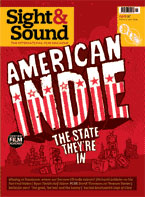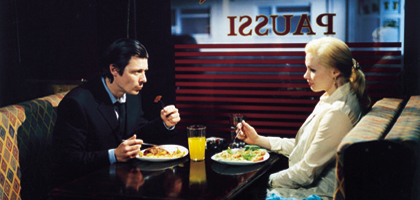Primary navigation

Finland/Germany/Italy/Sweden 2006

Reviewed by Ginette Vincendeau
Our synopses give away the plot in full, including surprise twists.
Helsinki, the present. Koistinen works as a night watchman in a luxury shopping mall. He leads a totally lonely life: he lives alone in a factory basement, his colleagues taunt or ignore him, and people in the local bar snub him. When he challenges three men who mistreat a dog they beat him up. Only Aila, a hot-dog seller at a mobile stand, talks to him. Planning to open his own security firm, Koistinen goes to night classes, but when he asks for a loan he is laughed out of the bank. One evening Mirja, a glamorous blonde woman, accosts him in a restaurant. He falls for her and they go out together - to the cinema, to a rock concert and to a restaurant. Unknown to him, she is the girlfriend of Lindholm, a crooked businessman who, with a Russian gang, is planning to rob the jewellery store in the shopping centre. Having obtained Koistinen's security code, Mirja spikes his coffee, and the gang successfully robs the jeweller. Koistinen is arrested and sent to jail for two years - but he says nothing of Mirja. Aila writes to him but he tears her letter up. Out of jail with no job, he finds the building where he lived demolished. He moves to a night shelter where Aila visits him. While washing up in a restaurant he spots Mirja with Lindholm and tries to kill the latter, but the crook's acolytes beat him up badly. Aila finds him, and they hold hands.
Aki Kaurismäki's Lights in the Dusk is a modern morality tale of loneliness in the postmodern city. A brilliantly minimalist work, it concludes the director's so-called 'loser trilogy' which began with Drifting Clouds (1996) and continued with the celebrated The Man without a Past (2002).
Koistinen (Janne Hyytiäinen) is a security guard, working the night shift in a luxury shopping mall. The film's opening sequences detail his utter isolation. Like a modern-day pariah he is shunned and taunted by co-workers for being a loser without a girlfriend, ignored by drinkers in a bar and beaten up by toughs when he points out that they are mistreating their dog. When he applies for a bank loan he is rejected in the most humiliating way. He ignores the affection of Aila (Maria Heiskanen), the hot-dog seller who is the only person to show him kindness. When beautiful blonde Mirja (Maria Järvenhelmi) accosts him out of the blue in a restaurant, he falls helplessly for her, unaware that she is manipulating him for her crooked boyfriend Lindholm (Ilkka Koivula), who is planning to rob the jewellery store in the shopping mall with a gang of Russians. But even after he has been sent to prison for two years and knows that Mirja has set him up, Koistinen still does nothing either to deliver the gang to the police or to save himself. That a man who is young, gentle and good-looking would be so completely rejected defies belief, but verisimilitude is not Kaurismäki's main preoccupation: Koistinen's loneliness is an existential condition rather than a sociological exposé. Which is why jail seamlessly continues his 'normal' lifestyle (indeed, the single shot of him smiling occurs in prison).
Lights in the Dusk is set in Ruoholahti, a district south-west of Helsinki recently developed as part harbour, part business park (it is the former home of Nokia) and part residential area. Kaurismäki presents it as an empty desert of gleaming glass and metal where, in typical postmodern fashion, different levels of society coexist but don't connect - the gated luxury mall, the factory basement where Koistinen lives, Aila's forlorn stall overlooking the harbour. The high-tech city of glass houses both the successful crook and the judiciary, but has no place for the ordinary worker who must live in the interstices of the new social order. Night shelter and security company alike contain people, but not communication: anomie is the rule. In this representation of the postmodern business centres of Europe, the sense of locality has given way to an anonymous 'any-city' that indeed could be anywhere in western Europe - Canary Wharf in London or La Défense in Paris for example.
Anonymity and the transcendence of local space are reinforced by mise en scène and cinephilic references. Several images deliberately gesture towards Edward Hopper (the bar, Aila's neon 'grilli' sign), while the pared-down aesthetics are evocative of film-makers such as Robert Bresson and Jean-Pierre Melville - the former in the consistently blank expressions of the actors, the latter in the blue-grey palette and details of the robbery (the violent contrast between the sumptuous jewels on crimson velvet and the drab surroundings recall Le Cercle rouge). Nor is Kaurismäki seeking spectacle: each of Koistinen's beatings is almost entirely left offscreen.
Unlike the extraordinary Koistinen, Kaurismäki draws on somewhat tired generic clichés for his two female characters - Mirja the glamorous femme fatale who cruelly lets him take the rap, and Aila the redemptive down-home girl who loves him from a distance. Never mind that Koistinen has been ignoring her throughout the film, their holding hands Pickpocket-style at the end is, in Kaurismäki's words, 'a spark of hope illuminating the final scene.' More original is the use of music. In contrast to the sobriety of the images, the soundtrack bursts with evocative, sensual and highly emotional music - Italian opera and fiery rock music (by Melrose in particular), but especially remarkable and suggestive is the tango, not only from Argentina but also from Finland (where, some may be surprised to learn, accordion music and tango have long flourished).
Some Kaurismäki aficionados might think Lights in the Dusk a disappointment after the more immediate appeal of The Man without a Past. The new film has been accused of being too thin, even given its (commendably) short length of 78 minutes. Perhaps this is why Kaurismäki withdrew it from this year's Academy Award competition for best foreign language film. Nevertheless, Lights in the Dusk is a highly original, strangely fascinating and self-assured work by Finland's best-known film-maker and one of the most important auteurs in today's European art cinema. As the leading Finnish film critic Peter von Bagh puts it, 'There is no single image that some other director might put his signature on, nor is there any stretch of dialogue someone else could have written.' There are those who will be put off by Koistinen's hangdog, masochistic apathy. But for those willing to enter the film's offbeat and deadpan universe, Lights in the Dusk is nothing short of mesmerising.